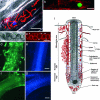The root endophytic fungus Piriformospora indica requires host cell death for proliferation during mutualistic symbiosis with barley
- PMID: 17116870
- PMCID: PMC1697795
- DOI: 10.1073/pnas.0605697103
The root endophytic fungus Piriformospora indica requires host cell death for proliferation during mutualistic symbiosis with barley
Abstract
Fungi of the recently defined order Sebacinales (Basidiomycota) are involved in a wide spectrum of mutualistic symbioses (including mycorrhizae) with various plants, thereby exhibiting a unique potential for biocontrol strategies. The axenically cultivable root endophyte Piriformospora indica is a model organism of this fungal order. It is able to increase biomass and grain yield of crop plants. In barley, the endophyte induces local and systemic resistance to fungal diseases and to abiotic stress. To elucidate the lifestyle of P. indica, we analyzed its symbiotic interaction and endophytic development in barley roots. We found that fungal colonization increases with root tissue maturation. The root tip meristem showed no colonization, and the elongation zone showed mainly intercellular colonization. In contrast, the differentiation zone was heavily infested by inter- and intracellular hyphae and intracellular chlamydospores. The majority of hyphae were present in dead rhizodermal and cortical cells that became completely filled with chlamydospores. In some cases, hyphae penetrated cells and built a meshwork around plasmolyzed protoplasts, suggesting that the fungus either actively kills cells or senses cells undergoing endogenous programmed cell death. Seven days after inoculation, expression of barley BAX inhibitor-1 (HvBI-1), a gene capable of inhibiting plant cell death, was attenuated. Consistently, fungal proliferation was strongly inhibited in transgenic barley overexpressing GFP-tagged HvBI-1, which shows that P. indica requires host cell death for proliferation in differentiated barley roots. We suggest that the endophyte interferes with the host cell death program to form a mutualistic interaction with plants.
Conflict of interest statement
The authors declare no conflict of interest.
Figures




References
MeSH terms
LinkOut - more resources
Full Text Sources
Molecular Biology Databases
Research Materials

